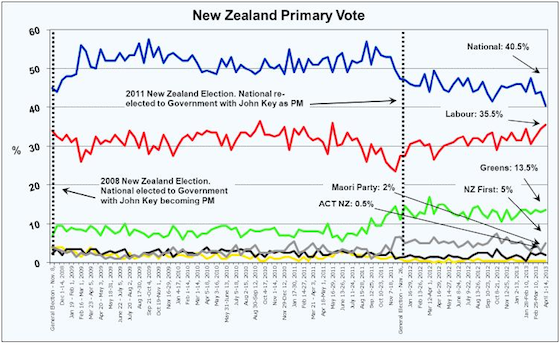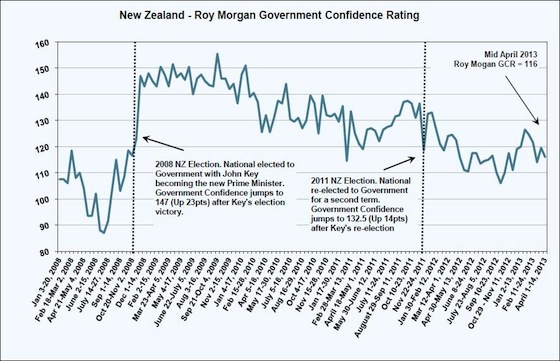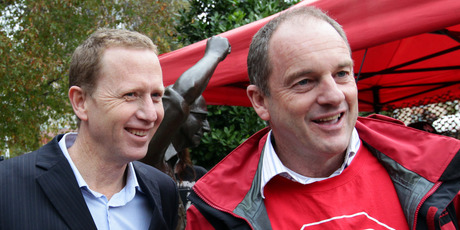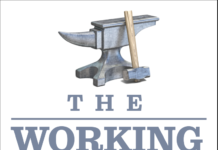
This week Gary Morgan of the Aussie-based Roy Morgan polling outfit said the latest poll result suggests: “… a clear boost to Opposition Leader David Shearer and comes as National faces a number of challenges that appear to have dented its support — the axing of 140 jobs by the Department of Conservation, the ongoing Novopay Payroll Issues, the bungled handling of the Kim Dotcom ‘affair’ and serious breaches of privacy by both the Ministry of Education and the Earthquake Commission.”
Polls are polarising and it’s debatable as to whether they are a true test of what the nation’s voters are truly thinking. But what is important are the trends.
The current New Zealand political trend is what concerns the right’s Matthew Hooton, David Farrar and others who can see that under MMP National’s hold on power is deminishing.
For the record this week’s Roy Morgan Poll shows, “a substantial fall in support” for Prime Minister John Key’s National Party to 40.5% (down 3.5% since March 11-24, 2013). Support for Key’s Coalition partners shows the Maori Party 2% (down 0.5%), ACT NZ 0.5% (unchanged) and United Future 0.5% (down 0.5%).
Here is the trend-graph that provides a feel for where things are heading.

In my view, National is suffering from a huge dent to its credibility armour, most recently and significantly due to the Prime Minister John Key’s ridiculous and unsustainable handling of the GCSB illegalities and his reticence to accept responsibility for the very agency he is paid to be responsible for. Right/conservative pundits take note: This is not just a beltway issue nor a media beat-up, and you know it.
The pollsters summarise the findings as: “If a National Election were held today this New Zealand Roy Morgan Poll shows that the Labour Party with minor party support would win an Election if held now.”
But centre-left supporters shouldn’t get too excited yet as the pollsters do not take into account the role New Zealand First would play should it achieve an above-the-threshold result in the 2014 General Election. Nor do these polls show any potential increase in support for the Conservative Party, especially should National’s decline become rapid.
For the Labour-Green voting bloc to establish itself as the Cabinet-In-Waiting it will need to achieve and sustain a solid voter-support-base of say 53 percent with Labour on par with (or above) National. On current trends that is possible.
In short, the Labour-Green bloc needs to exclude New Zealand First from the 50%+ option, and Labour needs to be on parity (or above) with National to counter New Zealand First’s potential claim that it doesn’t have a popular vote mandate to govern.
It is worth noting the views of the centrist social conservatives. In this morning’s New Zealand Herald, John Armstrong writes that:
“Labour and the Greens discovered one thing yesterday. The power of two (excuse the pun) is exponentially better than the power of one.”
I couldn’t agree more. He was of course writing about the encouraging Labour/Green power policy – for a great read on this check out Chris Trotter’s piece on The Daily Blog.
If the Labour-Green bloc is to win in 2014, it needs to present itself as the Australian right does, as a two-part coalition. Voters over the ditch know what they will get when they vote for that bloc. Kiwi voters should also have that assurance. And once Kiwi voters accept and embrace this, it exhausts the centre-centre-right’s argument that Labour’s only chance at government is by being propped up by a rag-tag bunch of opposition wannabies.
A true Labour-Green bloc will leverage off each other not erode into each other’s support-base. Once that is established, the voters will likely gravitate toward the party with the best solutions in ever-increasing numbers. So, it follows, the party with the best policy, that responds with relevance to sectorial and electorate needs, will make the best gains. That’s progressive politics. Any hint of negative jabs from either party would likely turn voters off. So Labour’s whips, and the Greens’ musterers have a big job ahead of them.
Back to the polls.
For number crunchers Roy Morgan states: “Support for Labour is 35.5% (up 1%); Greens are 13.5% (up 0.5%), New Zealand First 5% (up 2%), Mana Party 0.5% (unchanged), Conservative Party of NZ 1.5% (up 0.5%) and Others 0.5% (up 0.5%).”
Also, the National-led Government has suffered in the confidence ratings.

It would be very interesting if Roy Morgan checked voters’s views on the Prime Minister’s performance. It doesn’t which is a pity. For that we will need to evaluate other polls.
But, on the government confidence rating, this latest NZ Roy Morgan poll shows voter confidence down 3.5pts to 116 with 51.5% (down 2%) of New Zealanders saying New Zealand is ‘heading in the right direction’ compared to 35.5% (up 1.5%) that say NZ is ‘heading in the wrong direction’.
Statistical basis (click here for the raw poll):
Electors were asked: “If a New Zealand Election were held today which party would receive your party vote?”
This latest New Zealand Roy Morgan Poll on voting intention was conducted by telephone with a NZ wide cross-section of 879 electors from April 1-14, 2013. Of all electors surveyed 5.5% (up 1%) didn’t name a party. : April 18, 2013.






Two-Party Voting Bloc Work’s For Aussie’s Right So Why Not Also For NZ’s Left
Simple: the absence of preferential voting makes it inapt.
In addition:
1A. National and the Liberals have announced they will be in coalition after the next election.
1B. Labour and the Greens have not announced that they will be in coalition after the next election.
2A. National and the Liberals have a clear coalition operation, which continues in government and in opposition.
2B. Labour and the Greens have had the opportunity to be in a coalition with each other, and have never chosen to.
If Labour and the Greens actually make it work, and do so for a reasonable time, it may then be appropriate to actually treat them as two parts of the same entity (as would have been appropriate for Labour and the Jim Anderton’s Progressives). Until that happens, it’s wishful thinking.
Labour and the Greens have not announced that they will be in coalition after the next election.
Graeme, that is exactly my point. The two parties need each other in both opposition and government. It is time they developed the relationship (in a centre-left way) what the Aussie’s Lib/Nats have done.
What they achieved yesterday with the joint power policy, and what they did in 2012 re the manufacturing export debate, shows tag-team solution-based policy works both in progressive real-world terms and in garnering popular support.
Some sort of relationship is going to inevitably be needed because Labour will never be able to be in government without a coalition with the Greens again, unless it was to move sharply to the so called “left” which of course could lose its more centerists supporters.
People in general will be aware that if they vote for Labour they are voting for a Labour/Green coalition. The right will play on fears of those with a more centre right philosophy on life, and this fear could potentially put off potential Labour voters who fear (irrationally in my opinion) the Greens. So it is imperative that Labour and the Greens show early on that they can govern together and people have a good idea on where they stand united on key issues such as asset sales, education, the economy etc.
In this context, what has just happened is a very positive and sensible move on the part of both parties.
As Graeme said, Australia has an unfair voting system that forces parties into coalition. There is no need here for a voting block, and a lot of Green party workers would be disillusioned if Green policies were subject to agreement with Labour.
How quaint! People still believe there is a difference between National and Labour.
Comments are closed.